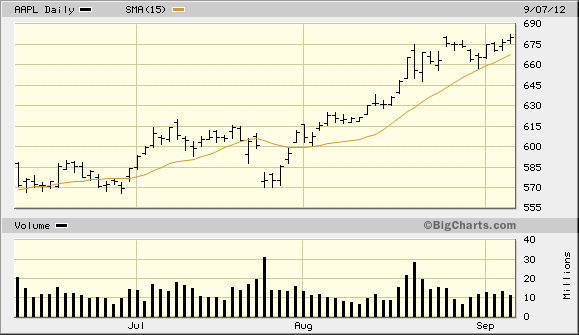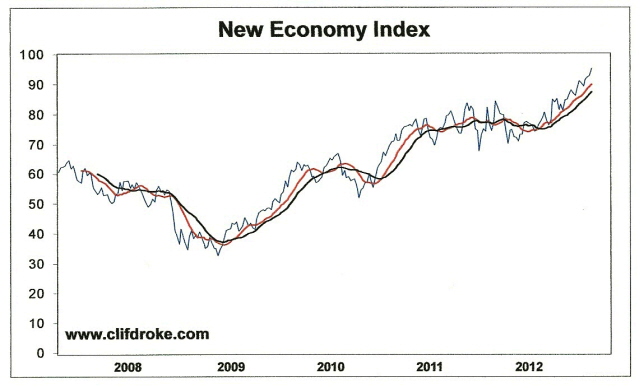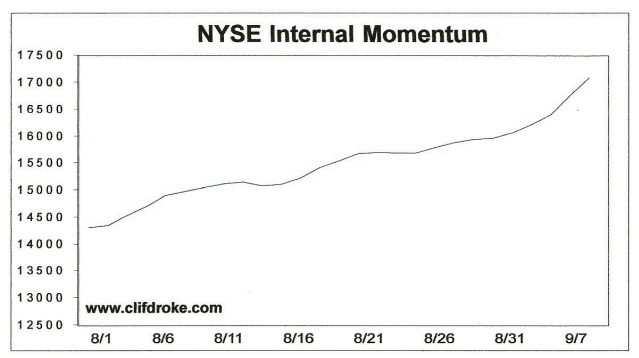The Effects of the 4-Year Stock Market Cycle Peak, Apple
Stock-Markets / Stock Markets 2012 Sep 09, 2012 - 11:09 AM GMTBy: Clif_Droke
 Last week was pivotal for equities as well as a reminder that the 3½ year-old recovery is still alive. Many stocks broke out to new recovery highs as the result of the European Central Bank's (ECB) announcement that it would commence a bond-buying program to stimulate the troubled euro zone economy. The S&P 500 (SPX) made its highest close in four years as stock prices across many sectors rallied on the prospect of increased liquidity, the lifeblood of any bull market.
Last week was pivotal for equities as well as a reminder that the 3½ year-old recovery is still alive. Many stocks broke out to new recovery highs as the result of the European Central Bank's (ECB) announcement that it would commence a bond-buying program to stimulate the troubled euro zone economy. The S&P 500 (SPX) made its highest close in four years as stock prices across many sectors rallied on the prospect of increased liquidity, the lifeblood of any bull market.
Before we get into the equity market outlook in light of the upcoming 4-year cycle peak, let's take a minute to discuss a subject of vast importance. Normally our focus is on the internal momentum of the NYSE broad market as well as the various stock market industry groups, such as gold stocks. Internal momentum is arguably the best measure of the incremental demand for stocks and is based on the new highs-new lows. Internal momentum is important because it tends to precede the direction of stock prices, i.e. if internal momentum starts rising while stock prices are falling, it's usually only a matter of time before stock prices turn around and follow the lead of internal momentum. Conversely, when internal momentum is declining while stock prices are rising, this divergence usually results in stock prices plunging at some point since internal momentum almost always leads stock prices.
With that said, let's turn our attention to the external momentum (i.e. price momentum) of the stock market as opposed to internal momentum. External momentum is the type of momentum that traders are most familiar with. It's easily identifiable by merely looking at the chart of the major indices or of any number of individual stocks or commodities. For instance, a stock that has established a rising trend above a moving average such as the 15-day, 30-day or 60-day MA, or a stock in which a rising trend line can be drawn is identified as a "momentum stock" by the conventional wisdom of Wall Street. The daily chart for Apple Inc. (AAPL) is an excellent example of a high profile "momentum stock" as shown below (Note: this is not a buy recommendation).

The problem with relying on external momentum to make trading decisions is that you never know when the momentum is going to dissipate. By the time an upward trend has become established in a stock or ETF, it's not uncommon for retail traders to jump in and buy under the assumption that the momentum will continue, only for the uptrend to fail and reverse as soon as they jump in. Trading external momentum is like flying an airplane without an instrument panel: it's theoretically possible I suppose but highly unadvisable. Internal momentum represents the "instrument panel" for trading stocks since it shows you what isn't visible on the surface of the market. Internal momentum in most cases gives you a good idea as to whether the uptrend in a particular market sector will continue or dissipate since you're looking at rate of change as opposed to simple linear extrapolation.
Having said all of this, there is one exception to the external momentum rule. The only time I ever trust external momentum over internal momentum is when it comes to reading the New Economy Index (NEI). The New Economy Index (NEI) reflects the market performance of the most critical U.S. consumer retailers and business service providers and is an excellent measure of the strength or weakness of the domestic retail economy. Unlike government economic statistics, it doesn't lag by a few weeks but presents a real-time picture of what's actually happening in the everyday U.S. business economy. The NEI is a simple average of the weekly stock prices of the leading components of the U.S. economy: online and bricks-and-mortar retail sales, transportation, employment, full-service consumer sales, etc. The stock price of the leaders in each of these sectors is averaged to give the weekly NEI reading.
Why is the NEI so important? Because in a bull market, the NEI is perhaps the single best reflection of how the U.S. retail business sector is holding up. NEI isn't always a leading indicator, but it nearly always coincides with tops and bottoms in not only the stock market but also the economy. NEI just made a new all-time high as Friday, August 31. This chart presents the picture of a still bullish consumer retail economic picture, one that Fed chief Bernanke is surely watching. The last time the Fed intervened with QE2, the NEI had preceded this by giving a "sell" signal. No such sell signal has been made in the New Economy Index since 2010. The positive picture in the NEI also explains why investors in recent months have been apt to treat even the slightest positive economic news headlines with a bullish response.

When NEI finally turns down and breaks below its 12-week and 20-week moving averages (see above chart), we'll have our first major indication that the recovery is ending. At present, most of the individual components of NEI are still holding steady near recent highs, but with an important exception: the stock of Fed-Ex (FDX) has been underperforming lately along with its competitor United Parcel Service (UPS). This is partly in response to the rising gasoline prices of recent weeks, but if this disturbing trend continues it will surely bode ill for the U.S. business economy at some point. Transportation is the backbone of business and both FDX and UPS are highly sensitive barometers which point to trends in the state of domestic small and mid-size businesses.
This is why it will be critical that we closely monitor the status of the New Economy Index in the next few weeks, for a reversal of the long-established uptrend in the NEI will signal a reversal of the bull market and economic recovery that has been underway these last couple of years. NEI is a prime example of how external momentum can be just as important as internal momentum in determining the direction of not only the stock market, but of the domestic economy as well.
Having examined the importance of external momentum, let's return to our discussion of NYSE internal momentum. Thursday's ECB announcement amounted as much to a resuscitation of the bull market for equities - and an additional boost for gold and silver - as a short-term rescue for the euro zone. From a technical perspective, the powerful rising trend in the NYSE dominant longer-term internal momentum indicator suggested that bullish news from Thursday's ECB meeting could spark a rally. News can be deceptive and hard to interpret in a directionless market. But when you have at least one or two key longer-term internal momentum indicators in a strong upward trend, good news tends to have a bullish effect on stock prices. This is why it's so important to monitor the longer-term internal momentum indicator (shown below).

The fact that the 4-year cycle is still peaking also played into the hands of the buyers after last week's ECB action. Central bank stimulus policy is far easier to implement when the forward momentum generated by the cycles is established as it has been this year to date.
Despite the breakout to new highs and the major internal improvements of the last two days there's still a question as to whether the stock market may have topped out in what could amount to little more than a short-term "blow off" or sucker's rally. A Reuters news article on Friday afternoon drew attention to this very subject as it called into question the staying power of the rally. The article's headline was the very epitome of skepticism: "A nice rally while it lasted." It's uncommon for a supposedly neutral news source like Reuters to take a definite position on the direction of the stock market, especially in a headline. This could be interpreted, from a contrarian perspective, as a premature call on this market rally, especially since mainstream news sources have a history of being wrong in their market calls.
On the opposite side of the fence was this week's Barron's cover. The cover speaks for itself as it suggests the bull market has staying power and will continue despite the efforts of the bears at stopping it. Might this also be interpreted as a contrarian signal that the bull market will in fact soon be halted?

Shedding some light on these conflicting news headlines is the latest AAII investor sentiment reading, released on Thursday. The AAII poll showed that the percentage of bullish and bearish investors were dead even at 33%, with the percentage of neutral investors also 33%. In other words, investors and media alike are at odds with each other about the short-term direction of the stock market. There is a near perfect division between bulls and bears, with both sides being nearly equal. Major tops are usually preceded by a surplus of bulls over bears for several weeks - normally around two or three months. Only in the last four weeks have there been more bulls than bears (not counting this week's neutral reading).
This brings us to the final consideration in our analysis of the stock market. The 4-year cycle is scheduled to peak around October 1, plus or minus a few days. That leaves us the better part of September before this important yearly cycle peaks. The rising 4-year cycle has provided a strong underlying support for the stock market for the bulk of this year and has confounded the bears up until now.
Another important factor is the Federal Open Market Committee (FOMC) meeting on Thursday, September 13. Many Fed watchers expect the central bank to commence another round of so-called quantitative easing (QE) to help stimulate the labor market. If the Fed disappoints these expectations, however, it could play into the hands of the bears.
The most important thing to watch will be the NYSE internal momentum indicators, which are based on the 52-week new highs and lows. As long as most of the individual internal momentum indicator components continue rising in the days ahead, the bull market should remain intact. Only if the key indicators reverse in the next several days will we have to worry about a premature peak for the stock market.
2014: America's Date With Destiny
Take a journey into the future with me as we discover what the future may unfold in the fateful period leading up to - and following - the 120-year cycle bottom in late 2014.
Picking up where I left off in my previous work, The Stock Market Cycles, I expand on the Kress cycle narrative and explain how the 120-year Mega cycle influences the market, the economy and other aspects of American life and culture. My latest book, 2014: America's Date With Destiny, examines the most vital issues facing America and the global economy in the 2-3 years ahead.
The new book explains that the credit crisis of 2008 was merely the prelude in an intensifying global credit storm. If the basis for my prediction continue true to form - namely the long-term Kress cycles - the worst part of the crisis lies ahead in the years 2013-2014. The book is now available for sale at: http://www.clifdroke.com/books/destiny.html
Order today to receive your autographed copy and a FREE 1-month trial subscription to the Gold & Silver Stock Report newsletter. Published twice each week, the newsletter uses the method described in this book for making profitable trades among the actively traded gold mining shares.
By Clif Droke
www.clifdroke.com
Clif Droke is the editor of the daily Gold & Silver Stock Report. Published daily since 2002, the report provides forecasts and analysis of the leading gold, silver, uranium and energy stocks from a short-term technical standpoint. He is also the author of numerous books, including 'How to Read Chart Patterns for Greater Profits.' For more information visit www.clifdroke.com
© 2005-2022 http://www.MarketOracle.co.uk - The Market Oracle is a FREE Daily Financial Markets Analysis & Forecasting online publication.



